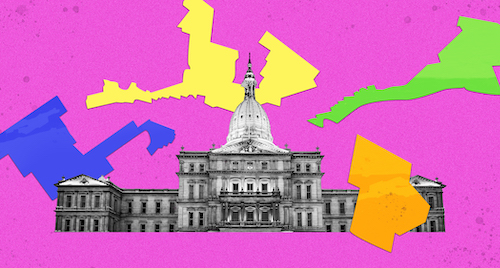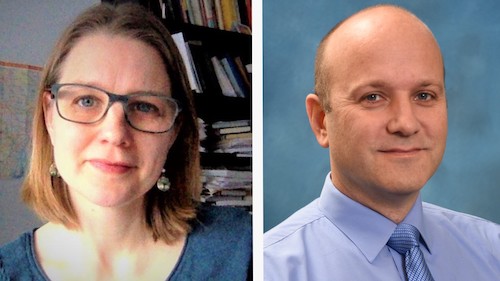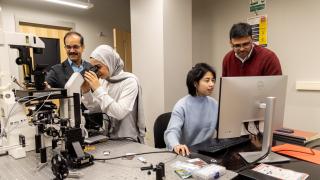The issue of voting rights has leapt to the center of American politics, and with it, the once fairly obscure political topic of gerrymandering. Right now, it’s a particularly big deal in Michigan. Back in 2018, more than 60 percent of voters approved Proposal 2, a constitutional amendment that created a new citizens commission to redraw Michigan’s heavily gerrymandered maps for state and national legislative districts. With important deadlines now looming in 2021, the work of that 13-member commission is reaching a critical phase. So we asked Associate Professors of Political Science Lara Rusch and Dale Thomson to catch us up on where things stand and how redistricting is likely to reshape Michigan politics.
How will redistricting reshape Michigan politics?
Two UM-Dearborn experts say undoing gerrymandering is a crucial step for maximizing representation. But it's not a magic bullet.


So for folks who haven’t been following the details of this redistricting thing, Lara, can you give us the quick backstory on how Proposal 2 came to be?
Lara: It’s actually a pretty interesting story. Back in 2016, a young woman named Katie Fahey posted on her Facebook page that she wanted to take on gerrymandering in Michigan. She got this huge response, which ultimately led to them forming the nonprofit Voters Not Politicians. They led this grassroots, volunteer-based organizing campaign to get this question of establishing an independent citizens redistricting commission in front of voters in 2018. A large majority of Michigan voters approved it, and so now we have this commission of “everyday” citizens made up of four Republicans, four Democrats and five who don't affiliate with either party. They’re currently putting in hours and hours of work, and hiring experts and staff to draw these new maps and hold public comment periods before the maps are implemented for the 2022 elections. What's remarkable about it to me is redistricting typically hasn’t been seen as the most exciting political topic. And yet all this interest shows that people really do understand that the shapes of the districts, and how they were engineered to favor a certain political party, really does affect what comes out of the legislature.
And when we are talking about gerrymandering, which, again, is this idea that representative district maps are drawn to make it unusually difficult for one party to win, just how big was the problem in Michigan?
Dale: Well, as part of the recent court case that was heard on this issue, Christopher Warshaw, who’s a political scientist from George Washington University, says that in terms of the Michigan Senate, our maps have a more pro-Republican bias than 99.7 percent of all state legislatures across the country in the past 45 years. So his conclusion is Michigan is the most gerrymandered state in the country. Importantly, he’s basing his assessment on what’s called an “efficiency gap,” and there are a lot of ways to measure gerrymandering. At face value, you can just look at the map and see these odd-shaped districts. But that has its limitations because some of those shapes are actually a result of trying to make sure minority voters have a voice. You can also look at statewide races, like governor or U.S. Senate or President, and if those races are generally going for one political party, but the state legislature is represented by the other party, that could be a sign of gerrymandering. And then there’s this efficiency gap, which tends to be the most accepted method. This measures the number of “wasted” votes, which is any vote not for the winning candidate or that the winning candidate didn’t need. To calculate the efficiency gap, you take the difference between 100 percent of the votes for the losing candidate and anything over 50 percent plus one vote for the winning candidate, and then divide that by the total number of voters. The basic idea is that if there are a lot more wasted votes for the party that loses the most races than there are for the party that wins the most, that indicates that we’re not splitting districts up in a way that’s competitive. Importantly, that doesn’t tell you whether a particular district is gerrymandered, but it does tell you the extent of manipulation or wasted votes across the state.
One other point that I want to make is Republicans have dominated our state legislatures in Michigan historically, but the issue with gerrymandering of late stems from advances in technology that enable rapid mapping of data at extremely fine levels combined with the fact that big data has enhanced our knowledge of voter behavior. Now you have political consultants who use these tools to cut these numbers at granular levels to find the most supportive map for whatever party is in power. In Michigan, as in the majority of states, that happened to be the Republicans, and that’s one of the reasons we have a map that’s so heavily engineered in their favor. In addition, these advances in technology have occurred at the same time that Republicans embraced the goal of aggressively stacking the electoral map in their favor. So while it’s true that gerrymandering has always been an issue, and to some extent, both parties do it when they have the chance, it’s really been catapulted to a whole new level.
So we’re still waiting to see exactly what methods the commission will use to draw up the districts, and as you said, part of it is sort of a math problem. But interestingly, Proposal 2 says districts should also try to reflect “communities of interest.” Can you explain that and why that’s important?
Lara: That’s a great question, and it gets to this issue of why this work is so complicated and why you can't just redraw the lines so they are a little less contentious and call it a day. So the law says the new districts have to be contiguous and roughly equal in population. But they also need to represent “communities of interest.” What this means is frankly not well laid out, and part of the work of the commission is to figure that out, which is why the public comment period is going to be so important. But we’re likely talking about things like economic factors, or cultural factors, including racial or ethic or religious ones. It could also take into account media markets or where school districts are. It’s not supposed to be based on party. It’s supposed to be based on the things that hold a community together in a way that speaks to state policy.
That sounds kind of mushy.
Lara: It’s very tricky! Frankly, it’s difficult for me to wrap my head around, and I think it’s probably hard for most citizens too.
Dale: I would agree, and in some ways if you take this idea of communities of interest to the extreme, you could actually reinforce the partisanship we’re seeing, because a community of interest today is often aligned with a political party, especially because people with similar politics are often clustered together geographically. But regarding the question of why you would want a community of interest, I think you can look to the Voting Rights Act, where communities of interest are about ensuring that minority voters have power. If you have a group of people whose voting power is diminished by being spread across different districts, then they effectively have no one representing them if the majority in the district is always getting their way. In the case of the Voting Rights Act, that’s framed in terms of race. But, as Lara says, there are other things that might contribute to a community of interest, like geography or the socioeconomic conditions of an area. Still, I think it’s going to be difficult to do this in a way that doesn’t just reinforce partisanship.
So I don’t like asking people to speculate, but how do you think this is going to play out? I mean, is redistricting likely to make that big a difference?
Lara: It’s difficult to say. In other states, it has created some more competitive districts, which makes sense, because if the district shapes shift, and public officials have to appeal to different constituencies, then it follows that there will be more opportunities for competition. But how many more competitive districts will there be? That’s hard to say. This is expanding the conversation a little bit, but in political science, there is a lot of interest in different kinds of electoral systems. And if we really wanted to represent people’s interests in policy, we’d have a more proportional system like most democracies have. In a proportionally representative system, we wouldn’t have geographic districts; for example, the whole state could be everyone’s district, and whatever percentage of the statewide vote your party got, that’s the percentage of seats you get in the legislature. So when we talk about redistricting as a way of making our legislative bodies more representative of people’s interests, I think we have to understand that as a tool, it’s just one of many, and its impact is somewhat limited.
Dale: This is an excellent point. The way district boundaries are established is a fundamental component of what creates the problematic politics we have. But single-member districts are another, because everyone who votes for the losing candidate effectively doesn’t get representation. Term limits are another. So we’re addressing one of these fundamental components in Michigan, and that’s fantastic, but as long as you have these other factors in play, your system of government is going to be problematic.
It’s hard to say how much of a difference this might make, but one metric to keep an eye on is where the real competition in elections is taking place. Right now, it’s at the primary level. So if the new maps are able to create competition among the parties in general elections, then you will see a substantially different dynamic in the way that candidates run for office and hopefully act once they are in office. If that doesn’t happen, then I don't think you'll see much of a difference, because the primary is where all the action will still be and that tends to result in more partisan candidates. Realistically, what is the proportion of districts where you could see some real general election competition? I would say it’s not very high. It’s probably most likely in the population centers in west and southeast Michigan, where the districts are geographically smaller. So statewide, the change may be marginal but it could be significant in some areas.
Finally, what’s the timeline for all this? I know there’s a ticking clock on drawing the maps, and I also heard delays with the 2020 census data are causing some issues.
Dale: The census data thing is really affecting what they can do. The final census data, which they absolutely need to draw the maps, was supposed to be available in April. Now, it’s not going to be available until the end of September and they’re supposed to have the maps drawn by November 1. And it’s in the Constitution that they shall do it by November 1, so how they're going to handle that is a good question.
Lara: I mean, really there’s not enough time to complete the process as it’s laid out. Even if it was feasible to draw the maps between the end of September and November 1, they won’t be able to do it in a way that allows for the public comment period, which is also required by the constitutional amendment. So will the state take it to the Supreme Court to get an extension? That’s one possibility.
Dale: And that could be significant because in a civil environment, you would think that thoughtful, calm heads would prevail and give the commission the time it needs to do its work properly. But in this hyper-partisan environment, I can easily envision legal challenges to any map that comes about from a process that deviates at all from the original timeline.
So this could get a little messy.
Lara: It might, but I also don’t want people to feel discouraged by all these challenges we’re bringing up. Yes, it’s true that redistricting is just one piece of a very messy puzzle in our politics right now, but I actually feel really positive about it. It’s a big deal that we now have this commission of “regular” folks, working across party lines, putting these issues out there about how to make our government more representative of what people want. I feel like we really need that in some form right now, and this happens to be a vehicle for doing that.
Dale: That’s such an important point. It’s easy to take away from this discussion that this is just a blip and it won’t make a difference. But political change rarely happens where you get massive change that addresses every problem simultaneously. Historically, change happens by building momentum in a particular area that spills over into another. That’s one of the things that’s encouraging about this whole process. I mean, this all started with a massive spontaneous response to a Facebook post. They got over 400,000 signatures to get this thing on the ballot. And to get 61 percent of voters to vote for something in this hyper-partisan environment is remarkable. It reflects that there’s a feeling out there that something needs to change. It’s people saying that even if we disagree on things, we want a good process to get to those policy decisions. Right now, we really don’t have that, and this is one of the fundamental steps toward getting there.
###
Interview by Lou Blouin. If you're a member of the media and would like to contact Associate Professors Lara Rusch or Dale Thomson for an interview on this topic, drop us a line at [email protected].




